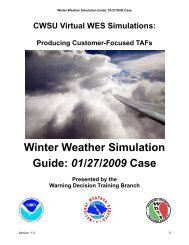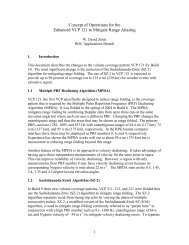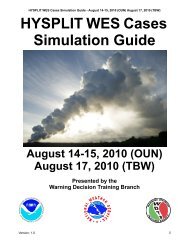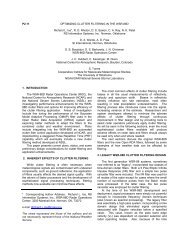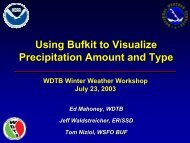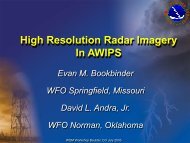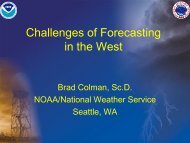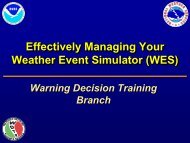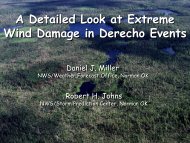PDF of the RPG training presentation
PDF of the RPG training presentation
PDF of the RPG training presentation
You also want an ePaper? Increase the reach of your titles
YUMPU automatically turns print PDFs into web optimized ePapers that Google loves.
Welcome to <strong>the</strong> <strong>RPG</strong> Build 13.0 operator <strong>training</strong>.1
This <strong>training</strong> presents several features that will not be apparent until your RDA hasbeen upgraded to Dual-Pol, which is RDA Build 12.3. For example, <strong>RPG</strong> Build 13.0has adjustments to <strong>the</strong> Dual-Pol <strong>RPG</strong> algorithms, which aren’t operational until youhave Dual-Pol. Also, CMD & AVSET both go away with RDA Build 12.3, but areexpected to return beginning in late Summer 2012.There is one new feature with <strong>RPG</strong> Build 13.0 that is independent <strong>of</strong> <strong>the</strong> RDA Build.It is called <strong>the</strong> Enhanced VAD Wind Pr<strong>of</strong>ile (VWP). This is not a replacement for oran addition to <strong>the</strong> VWP product. Changes are made at <strong>the</strong> <strong>RPG</strong> that t improve <strong>the</strong>quality and quantity <strong>of</strong> available winds “barbs” on this product.2
Since <strong>the</strong> Dual Pol upgrade to <strong>the</strong> WSR-88D fleet is so significant, <strong>the</strong> updates toboth <strong>the</strong> <strong>RPG</strong> and <strong>the</strong> RDA will be more complicated than usual at least through2013. All <strong>of</strong> this information applies to WSR-88D Single Thread (not Redundant)sites.The initial Dual Pol upgrade is RDA Build 12.3, which does not have ClutterMitigation and Decision (CMD) or Automated Volume Scan Evaluation andTermination (AVSET). As <strong>of</strong> this writing, both CMD and AVSET return with RDABuild 13.0, which is scheduled to be deployed August 2012.3
Here are <strong>the</strong> highlights <strong>of</strong> <strong>the</strong> <strong>RPG</strong> Build 13.0 features for an RDA that has beenupgraded to Dual Pol, but not yet to RDA Build 13.0. There are new statusmessages related to Dual Pol on <strong>the</strong> <strong>RPG</strong> Status window. There are a number <strong>of</strong>minor adjustments to <strong>the</strong> <strong>RPG</strong> algorithms, especially <strong>the</strong> new Dual Pol <strong>RPG</strong>algorithms. <strong>RPG</strong> Build 13.0 will not bring back CMD and AVSET. RDA Build 13.0 isneeded for that, and it is expected to be deployed Summer 2012.The one feature <strong>of</strong> <strong>RPG</strong> Build 13.0 that has nothing to do with Dual Pol is <strong>the</strong>Enhanced VAD Wind Pr<strong>of</strong>ile (EVWP) product. The EVWP will increase both <strong>the</strong>availability and <strong>the</strong> accuracy <strong>of</strong> <strong>the</strong> WSR-88D calculated winds al<strong>of</strong>t.4
Here are <strong>the</strong> new status messages at <strong>the</strong> <strong>RPG</strong> Status window that are related toDual Pol. There are three entries, which are generated every volume scan. The firsttwo start with “RDA CAL” and <strong>the</strong> third starts with “ZDR Stats”. The RDA CALinformation is used for engineering analysis. The ZDR Stats information is also usedfor engineering analysis, as well as research to “fine tune” <strong>the</strong> <strong>RPG</strong> algorithms.These numbers are experimental in nature and not for operational use. For those <strong>of</strong>you upgrading from previous Dual Pol builds, <strong>the</strong>se messages have not changed.5
Here’s a list <strong>of</strong> <strong>the</strong> <strong>RPG</strong> algorithm adjustments that are part <strong>of</strong> <strong>RPG</strong> Build 13.0. Thefollowing slides will discuss <strong>the</strong>se in detail, including spelling out all <strong>the</strong>se acronyms!6
There are two additional URC threshold parameters supporting VCP 121, whichuses <strong>the</strong> Multiple PRF Dealiasing Algorithm (MPDA). They are “Tight Overlap Size”and “Loose Overlap Size”. Though <strong>the</strong> names may not be intuitive, <strong>the</strong>se settingseliminate some occasional noisy velocity data that have been noticed in <strong>the</strong> past. Ifnoisy velocity data are observed with VCP 121, contact <strong>the</strong> Hotline for guidance onchanging <strong>the</strong> values.7
The Melting Layer Detection Algorithm (MLDA) is one <strong>of</strong> <strong>the</strong> new Dual Pol <strong>RPG</strong>algorithms. It uses data (legacy and Dual Pol) from 4 to 10 degrees to identify <strong>the</strong>melting layer. These higher elevations are necessary to avoid clutter and o<strong>the</strong>r lowlevel data quality problems. An overlay product is generated for each elevationangle that depicts where that elevation angle would intersect <strong>the</strong> computed meltinglayer.MLDA works best with widespread returns that are deep enough for <strong>the</strong> 4 to 10degree search to be successful. MLDA can be “cold season challenged”, in <strong>the</strong>sense that <strong>the</strong> true melting layer can be too close to <strong>the</strong> ground for <strong>the</strong> algorithm t<strong>of</strong>ind it.8
The MLDA has one adaptable parameter, called “Use MLDA Heights”. The Defaultsetting is Yes, which means use <strong>the</strong> data from 4 to 10 degrees to attempt to find amelting layer.Sometimes, <strong>of</strong>ten during <strong>the</strong> cold season, <strong>the</strong>re may not be enough data from 4 to10 degrees for MLDA to find a melting layer. In that situation, setting “Use MLDAHeights” to No uses <strong>the</strong> 0° C height from <strong>the</strong> <strong>RPG</strong> Environmental Data to build <strong>the</strong>ML products and for ingest to <strong>the</strong> QPE algorithm.When <strong>the</strong> single 0° C height is used, that height is assumed to be <strong>the</strong> top <strong>of</strong> <strong>the</strong>melting layer, while <strong>the</strong> bottom is assumed to be 500 m below <strong>the</strong> 0° C height. Thus<strong>the</strong>re is an assumed depth <strong>of</strong> <strong>the</strong> melting layer when <strong>the</strong> 0° C height from <strong>the</strong> <strong>RPG</strong>Environmental Data is used.9
<strong>RPG</strong> Build 13.0 has a change that is applied when <strong>the</strong> MLDA detects a meltinglayer top <strong>of</strong> < 1 km ARL (a rare event!) or <strong>the</strong> RUC data has a 0° C height < 1 kmARL. If ei<strong>the</strong>r <strong>of</strong> <strong>the</strong>se conditions occur for a volume scan, <strong>the</strong> RUC 0° C height isused for <strong>the</strong> melting layer. The s<strong>of</strong>tware essentially bypasses <strong>the</strong> setting <strong>of</strong> “UseMLDA Heights” for that volume scan.10
The Dual Pol Quantitative Precipitation Estimation (QPE) product suite includes twodifference products, Digital One Hour Difference (DOD), and Digital Storm TotalDifference. In each case, <strong>the</strong> product reflects <strong>the</strong> QPE accumulations minus <strong>the</strong>legacy PPS accumulations. Independent <strong>of</strong> one ano<strong>the</strong>r, <strong>the</strong> QPE and PPS stormtotal accumulations automatically reset to zero after a one hour period withconditions below <strong>the</strong>ir respective thresholds.The QPE difference products also automatically reset to zero when both <strong>the</strong> QPEand PPS accumulations have automatically reset.<strong>RPG</strong> Build 13.0 <strong>of</strong>fers <strong>the</strong> new option to do a direct manual reset <strong>of</strong> <strong>the</strong> Differenceproducts, both <strong>the</strong> one hour and <strong>the</strong> storm total durations.11
Attenuation and Non-uniform Beam Filling (NBF) each have a unique impact onDual Pol products. They <strong>of</strong>ten occur at <strong>the</strong> same time, as with this intense squallline that is oriented parallel to several radials. There is significant attenuation <strong>of</strong> Z,which is just <strong>the</strong> horizontal part <strong>of</strong> <strong>the</strong> transmitted pulse. There is also significantdifferential attenuation in <strong>the</strong> ZDR product. The beam is passing through numerouslarge raindrops, which have a much larger horizontal extent compared to <strong>the</strong>vertical. There is more attenuation loss in <strong>the</strong> horizontal compared to vertical,resulting in a significant underestimate <strong>of</strong> ZDR down radial from <strong>the</strong> squall line.Non-uniform beam filling is also affecting <strong>the</strong> CC product for this case, which ispresented on <strong>the</strong> next slide.12
For this case, <strong>the</strong>re is also an extreme underestimate <strong>of</strong> CC down radial from <strong>the</strong>squall line. This is <strong>the</strong> impact <strong>of</strong> NBF, where <strong>the</strong>re is a gradient <strong>of</strong> precipitation typesand thus a gradient <strong>of</strong> PhiDP within <strong>the</strong> beam.13
Attenuation and non-uniform beam filling result in underestimations <strong>of</strong> both ZDR andCC. The Hydrometeor Classification Algorithm (HCA) doesn’t know any better (itsan algorithm) and <strong>of</strong>ten misclassifies echo in <strong>the</strong>se areas. For example, instead <strong>of</strong>rain, heavy rain, wet snow or dry snow, many <strong>of</strong> <strong>the</strong> bins in this “swath” areidentified as clutter, biological, or unknown. This significantly affects <strong>the</strong>performance <strong>of</strong> <strong>the</strong> QPE in estimating rainfall.14
Some testing was conducted regarding <strong>the</strong> “sensitivity” <strong>of</strong> <strong>the</strong> <strong>RPG</strong> Dual Polalgorithms to non-uniform beam filling. Adjustments were made to mitigate <strong>the</strong>affects <strong>of</strong> non-uniform beam filling and attenuation for events like squall lines. Forthis squall line case, <strong>the</strong> HC product is shown with <strong>the</strong> pre-Build 13.0 parametersettings at <strong>the</strong> top, and <strong>the</strong> Build 13.0 parameter setting at <strong>the</strong> bottom.Since QPE performance is directly dependent on <strong>the</strong> HCA output, <strong>the</strong> next slideshows how <strong>the</strong>se parameter adjustments can improve QPE.15
Since QPE performance is directly dependent on HCA output, mitigating <strong>the</strong>impacts <strong>of</strong> attenuation and non-uniform beam filling ultimately improves rainfallestimation. Without <strong>the</strong> adjustments, zero rain rates show up in a large area downradial from <strong>the</strong> squall line on <strong>the</strong> top image. With <strong>the</strong> <strong>RPG</strong> Build 13.0 adjustmentson <strong>the</strong> lower image, <strong>the</strong> QPE rain rate product looks much more realistic.16
These “ZDR spikes” are known artifacts from <strong>the</strong> Dual Pol <strong>RPG</strong> Preprocessoralgorithm. The frequency <strong>of</strong> occurrence is highly variable. Some <strong>of</strong> you may haveseen this rarely, while o<strong>the</strong>rs may have seen it more <strong>of</strong>ten. An <strong>RPG</strong> Build 13.0adjustment to <strong>the</strong> Preprocessor is expected to reduce <strong>the</strong> frequency <strong>of</strong> <strong>the</strong>se ZDRspikes.17
The fielding <strong>of</strong> AVSET and Dual Polarization are related to one ano<strong>the</strong>r, in <strong>the</strong> sameway as CMD and Dual Pol. The RDA s<strong>of</strong>tware that was used to develop Dual Poldid not have AVSET or CMD. When your RDA is initially upgraded to Dual Pol (RDABuild 12.3), CMD and AVSET will not work until RDA Build 13.0 is installed. RDABuild 13.0 is currently scheduled to begin deployment during <strong>the</strong> Summer <strong>of</strong> 2012.While CMD and AVSET are unavailable, <strong>the</strong>ir default status on <strong>the</strong> <strong>RPG</strong> will bePENDING and DISABLED, respectively.18
<strong>RPG</strong> Build 13.0 has one new feature that is independent <strong>of</strong> Dual Polarization. It isan improved way <strong>of</strong> generating <strong>the</strong> Velocity Azimuth Display (VAD) Wind Pr<strong>of</strong>ile(VWP) product. The result is a greater availability and accuracy <strong>of</strong> <strong>the</strong> WSR-88Dcalculated winds on <strong>the</strong> VWP product. The original VWP design uses a single windestimate derived from a radar elevation angle closest to a particular slant rangevalue. The Enhanced VWP design computes multiple wind estimates from radarelevation angles closest to multiple slant ranges. The underlying VAD processing foreach wind estimate has not changed. For each height, <strong>the</strong> “best” wind is chosen if<strong>the</strong>re is more than one available.19
The original VWP design uses a single wind speed and direction estimate for eachheight. The radar elevation angle closest to <strong>the</strong> slant range, an adaptableparameter, was used to calculate <strong>the</strong> VAD wind for that height. If <strong>the</strong>re wassufficient radar return at that elevation angle for an estimate, a single wind for tha<strong>the</strong>ight was calculated and used on <strong>the</strong> VWP product.20
The Enhanced VWP has a more robust design, allowing for multiple winds to becalculated for each VAD height. In addition to <strong>the</strong> one wind estimate calculatedusing <strong>the</strong> original method, o<strong>the</strong>r slant ranges and elevation angles are used tocalculate supplemental wind estimates for each height. There are a number <strong>of</strong>constraints to keep <strong>the</strong>se “possible” winds sufficiently accurate.21
In order to calculate more than one wind, additional slant ranges are used. There isa formula that increases <strong>the</strong> slant range as <strong>the</strong> elevation angle increases. In orderfor any wind from any elevation to be considered, <strong>the</strong>re is an “error test”requirement that ensures that any error in <strong>the</strong> estimate is sufficiently low.Since EVWP calculates more than one possible wind for any given height, how is asingle wind chosen? A validity weight or validity index is calculated, which takes intoaccount <strong>the</strong> error, <strong>the</strong> wind speed, and <strong>the</strong> number <strong>of</strong> points used to generate <strong>the</strong>wind estimate.t22
This table summarizes how <strong>the</strong> original VAD wind estimate is used along withsupplemental winds. The result (examples on <strong>the</strong> next few slides) is a VWP productwith a larger number <strong>of</strong> wind estimates available and an overall higher validity <strong>of</strong> <strong>the</strong>estimates.23
Example 1: Old VWP is on <strong>the</strong> left and (for <strong>the</strong> same data) EVWP on <strong>the</strong> right. Alsoincluded are <strong>the</strong> number <strong>of</strong> wind estimates available for <strong>the</strong> VWP vs. <strong>the</strong> EVWP.24
Example 2: Old VWP is on <strong>the</strong> left and (for <strong>the</strong> same data) EVWP on <strong>the</strong> right. Alsoincluded are <strong>the</strong> number <strong>of</strong> wind estimates available for <strong>the</strong> VWP vs. <strong>the</strong> EVWP.25
Example 3: Old VWP is on <strong>the</strong> left and (for <strong>the</strong> same data) EVWP on <strong>the</strong> right (nowind estimate numbers for this example).26
Thank you for your time and please let me know if you have any questions.27




